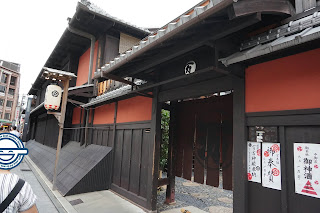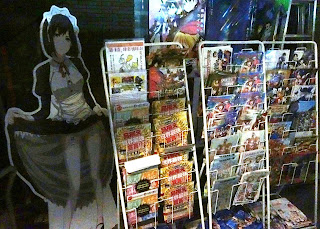 |
| The hostel was located in a small alley. |
These types of places are super cheap, and this particular guesthouse had decent amenities so I won't say it was a horrible experience, but at times it smelled like being at an anime convention. It was fine as a single time experience, but I probably won't be staying in a hostel again if I can help it.
My previous visit to Kyoto was entirely for cultural purposes, but on this trip I wanted to take some time to look into where people could go to shop for their anime stuff. As it turns out, the central location was not much more than a 5 minute walk from where we were staying.
The first location is the Shinkyougoku Shotengai, which has been described as being filled with stores selling tacky souvenirs.
 |
| Kyoto Olympia photo booth shop at Shinkyougoku x Takoyakushi-dori. |
Near the intersection of Shinkyougoku and Takoyakushi-dori there is a Yellow Submarine on the 4th floor of the building shared with Ichiran Ramen.
 |
| Yellow Submarine TCG shop |
Other nearby stores include a gashapon machine hall, a small figure shop, and a rental showcase shop.
If you make a left at the intersection, you will find Animate, which also happens to be neighbors with a manga and anime capsule hotel.
 |
| Animate is up the stairs. |
The other street is Teramachi Shotengai, where the story of Kyōto Teramachi Sanjō no Holmes is set.
The Teramachi Shotengai has been called refined, but I think that may be referring to the area north of the intersection of Teramachi and Sanjō-dori, where a number of art galleries are established. In the part of the street around Shijō-dori, you will find the likes of Lashinbang, Melon Books, and Toranoana.
Lashinbang is just off Teramachi-dori on Rokkaku-dori. There were a couple of Chibi Kyun figures I saw there that I should have bought, but thought were too expensive at the time. They were going for 2-4 times that price in Tokyo.
 |
| Lashinbang (it's the blue sign) |
I did take several free registration forms for various events from a rack outside of the store as souvenirs though.
 |
| Melon Books |
 |
| Toranoana |
As I was passing by Toranoana, a nice, older normie couple were stepping into the store exclaiming "Oh, a mainga shop!" I was thinking about giving them a heads up, but decided it was none of my business. I apologize in advance to little Tommy who will probably have his anime and manga purchases under close scrutiny and possible criticism from now on.
One other location where you can find goods is at the Yodobashi Camera near Kyoto Station. I went there to buy a power adapter for my laptop, but they have a nice selection of toys and models that are very competitively priced.
Of course the majority of the places I went were cultural, so don't get the wrong idea. In fact, the only thing I bought was a Kaiyodo gashapon figure of the six-armed Ashura from the Kohfukuji Kokuhoukan. This was more of a memento of a side trip we made to Nara than anything related to Kyoto.
 |
| Capsule Q Museum Budda [sic] Statue Collection I |
Some of the places I visited in Kyoto included:
Gion
Gion is the geisha district of Kyoto, stretching from the front of Yasaka Shrine to the east bank of the Kamo River. It is also the location of the famous Minami-za, a kabuki theater that nowadays is also used for other types of stage performances.
 |
| Minami-za |
While I was there, a Sakura Taisen show was running. I would have liked to go see it, but you can't always do what you want when travelling with others.
 |
| Yasaka Shrine |
 |
| Ducks on the Kamo River |
July is the month of the Gion Matsuri of Yasaka Shrine, but I didn't plan properly, so we ended missing both the Yamaboko Junko on the 17th and the 24th.
 |
| Procession of yama and hoko floats represented in miniature at Kyoto Station. |
During the three nights leading up to each parade, the shrine is open until 10pm.
 |
| Yasaka Shrine on yoiyoiyoiyama |
Another popular place to visit is Hanami-koji, which starts from Ichiriki Chaya (famous for being mentioned in the Tale of the 47 Ronin), and runs all the way south to Kennin-ji. The street is lined with traditional teahouses.
 |
| Ichiriki Teahouse |
 |
| Hanami-koji |
 |
| Etiquette for Hanami-koji |
Nishiki Market
Nishiki Market has been popularized by foodies like Jackie Chen. It is lined with restaurants and shops selling ingredients for traditional Kyoto cuisine.
On one of the side streets there was some sort of event going on, because all the people lining the sides of the street were playing Pokémon GO!
 |
| There were twice as many people playing right before I took this photo. |
Arashiyama
Location of the Arashiyama Monkey Park, Arashiyama Bamboo Grove, and many shrines.
 |
| Togetsukyo Bridge |
 |
| Boats on the Hozu River |
 |
| Arashiyama Bamboo Grove |
Near the Arashiyama Bamboo Grove there are private bamboo gardens that charge ¥3500 for entry. These are not the same as the popular grove that everyone takes their pictures at (which is free).
 |
| Seiryo-ji |
 |
| Temple grounds |
Many of the temples of Arashiyama charge a small entrance fee to visit the grounds. I didn't enter any of them since it was just a day trip, but maybe next time.
On a more somber note, I had originally planned on paying a visit to Demachi Masugata Shoutengai and the Kyoto Animation Studio in Fushimi, but I put off the plans after seeing the news on TV about the terrible event that happened in the morning before our arrival.
Instead, I decided to make a donation to the KyoAni fund. For those who want to make smaller contributions, TRSI is running a fundraiser to collect donations that will be combined as a lump sum so that people won't be charged with international bank transfer fees. The fundraiser ends August 31st.














No comments:
Post a Comment